How To Repair A Notched Ceiling Joist
Repair Sagging, Cracked or Broken Flooring Framing.
Past Rob Robillard
I recently had to repair a floor joist that had croaky. I suppose somewhere in the earth there are flooring joists that demand to be repaired that have broad open, clear joist bays, with no pipes, wires or obstructions. Unfortunately, that'south not my earth.
This joist was installed in 1863 and was located directly below where a heavy refrigerator now lives. From initial inspection it appeared that someone had notched the joist likewise much and so installed a makeshift patch. The notch was made where the floor joist recessed into a wood beam, supported by chimney corbeling.

Corbeling is an "old school," overlapping organization of bricks with each course extending farther out from the vertical of the wall than the course below. Corbeling was done for decoration or to back up structural beams, like in this situation.
My guess is that many years back, an onetime vent or furnace pipe ran through this location, and the contractor needed to cut this department of joist to accomplish the installation. Today, this type of notch is not immune by lawmaking.
Notches can compromise the force of floor joists, although some notches are adequate, depending on their location as dictated past the International Residential Code [IRC]. Here's a good rule of thumb:
- Notches should exist no deeper than 1/half-dozen the depth of the joist.
- Notches at the terminate of the joist should be no deeper than 1/4 the depth.
- Limit the length of notches to 1/3 of the joist'south depth.
Not only did the aggressive notching doom this joist, it affected the structural integrity of the floor system higher up. To make matters worse, the refrigerator above our joist was causing the flooring to sag.
A severely, croaky or sagging floor joist can get worse over fourth dimension, causing the floor in a higher place information technology to slope or become unleveled.
Tools & Materials Required
- Level
- Reciprocating saw
- v-pound hammer
- Tape measure out
- Structural screws and joist hangers if applicable
- Power saw
- Framing lumber or laminated lumber if needed for strength
- Wood shims
- Hydraulic jack or metallic jack posts
- Misc. mitt tools
- Impact driver and accessories

Sis Joist
Correcting a trouble joist is an easy repair and is usually accomplished past fastening a new joist next to a damaged floor joist, doubling the thickness of the framing fellow member. This is referred to as "sistering."
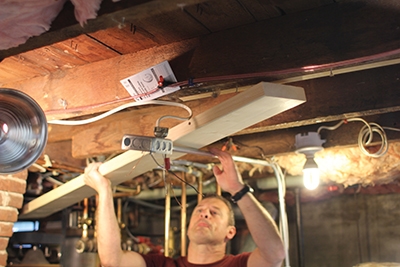
This floor system was built in 1863 and was later reinforced with a mid-span beam approximately seven feet away. The damaged joist measured exactly two inches by 6-i/4 inches deep—a true 2×vi.
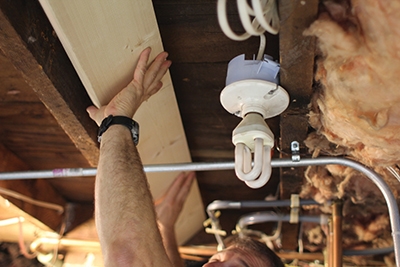
My approach was to install a new joist next to it, resting one end 3 inches onto the mid-span beam and installing a joist hanger on the other side. I would sister the two together with structural screws.
The infinite between the axle and the floor boards above was vii inches and then I decided to utilize regular framing lumber and rip a 1/2-inch off the width of a 2×8 framing member. (Annotation: A nominal 2×viii board measures 1-1/two past 7-i/2 inches.)
Cut the New Joist
When installing a new joist on a foundation wall you may demand to notch the bottom edge so it can fit. Each state of affairs is unlike. Follow IRC and your local building code guidelines for notching framing textile before doing this repair.
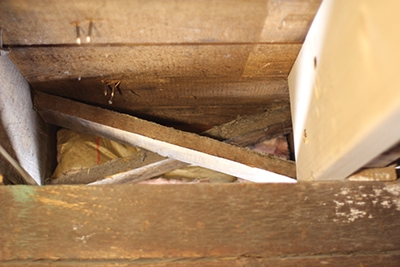
I used a circ saw to cut the new joist and then it would sit down three inches on top of the beam. Afterward cutting to length, I then ripped the new joist to fit.
Room for the repair
I had a few obstructions in my way; there were electric wires, thermostat cables, a refrigerator water line, electric conduit and heating pipes in the area. I also found old nails and piping brackets, left in place from years past—I hate that.
The first step was to temporarily remove or relocate the electric cables and pipes. This necessitated shutting off the electricity and disconnecting a smoke alarm and some thermostat wiring. I likewise had to pull wire staples and unscrew conduit and heating piping supports. These items would all need to exist replaced after sistering the joist.
Once complete I checked the subfloor above for whatsoever penetrating nails that would inhibit the new joist. I found none, but I would have used end nippers and cutting them flush with the subfloor.
I also removed all the nails and former pipage hangers left from sometime mechanicals.
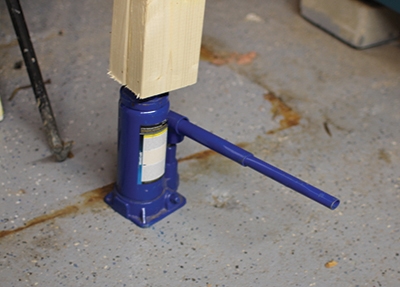
Jacking the Joist
I positioned the new joist in place and so ready a 6-ton hydraulic jack with a jack post. The new joist fit in the infinite sideways just would not tilt into vertical position. The reason was the corners of the new joist, when at a 45-degree angle, caught the height of the axle and the bottom of the flooring boards. One time the joist was vertical it would fit fine—hence the slight floor jacking.
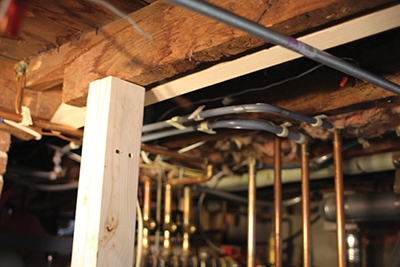
I fastened 2 two×4'due south together to brand a simple jack post. I then plumbed the 2×4 jack post and placed it directly under the cracked joist in society to lift a pocket-size sag out of the old joist as well as create a tiny fleck of room for me to get the new joist against the erstwhile one at the beam.
A notation on jacking: Jacking too fast can crusade wall cracks above and many times information technology'due south better to jack slowly. A good rule of thumb is to jack only 1/viii inch a day, to get a joist level.
After lifting the croaky joist, I used a 5-pound hammer to carefully move the new joist into position.
I needed to hammer the joist simply where it sat on the beam, since this is where the joist was catching.
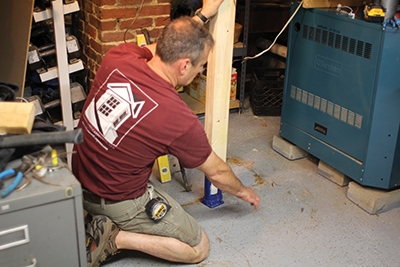
If the new joist is hitting a beam and the floor above, and jacking is not an option, an alternative approach is to cut small bevels on the two opposing edges that the touch the beam and floor board. This helps the joist turn into the proper resting position.
Making a Jack Post
I made a fast and simple jack postal service with two 2×four screwed together. I was not lifting a lot of weight or lifting and holding for a long period of time so I chose non to brand a "stiff back" or "T-jack" mail service. T-shaped posts are stronger because the 2×iv boards oppose each other and counteract any angle force created during jacking.
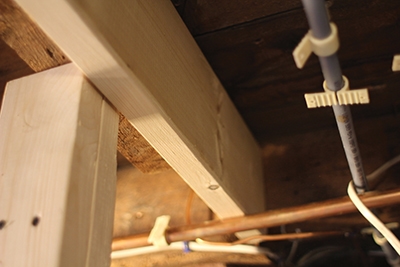
To make a T-shaped post, nail your pairs of 2x4s together, perpendicular to each other in the form of a "T." Secure them with framing nails or structural screws.
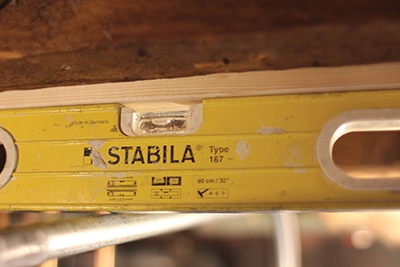

Installing the Sister Joist
After the new joist was in place (vertical and side by side to the old joist), I used a clench to hold them together at the chimney finish.

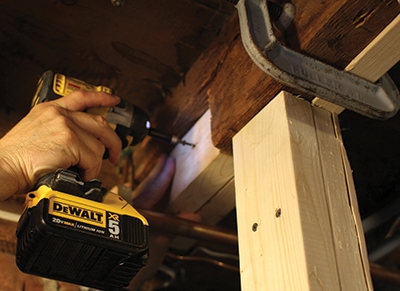
Cut a block to the fill the notch and screw it in place.I patched in the notch on the one-time joist, mostly so I had structural bearing to mount the joist hanger. I also added a shim board to the width, to keep the hanger from deforming when fastened.
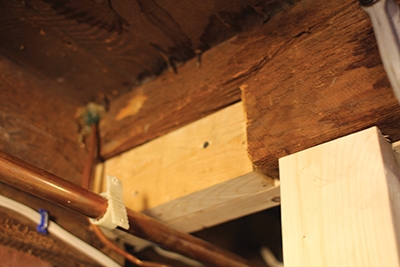
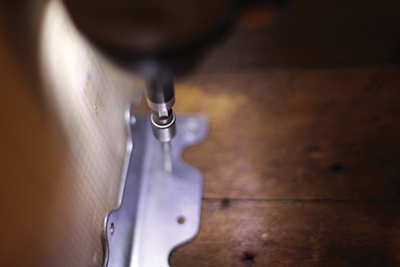
I then relocated the jack under the joist and placed a slight amount of pre-stress tension on it, ensuring that I was level, and installed a double joist hanger to back up both the former and new sis joist.
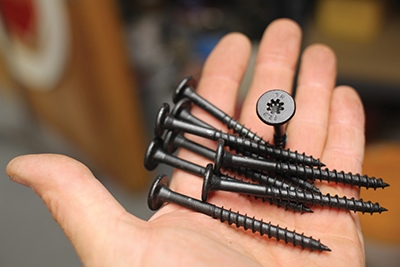

The joist hanger was designed for "old work" and fits the wider faming textile oftentimes found in older homes. I secured the joist hanger into the corbel supported axle with 2-1/2-in. structural screws and into the joists with1-i/ii-in. structural screws.
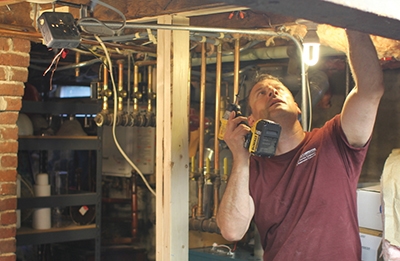
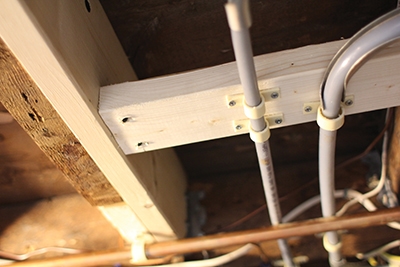
To adhere the new joist to the older one, I installed a serial of iii-in. structural lag screws. In one case secured, I released the jack pressure and removed the jack.
Call In A Structural Engineer
If yous're concerned virtually the structural integrity of a sagging, croaky or twisted joist in your house, first call a structural engineer to audit the floor. Get a recommendation for reinforcement and strengthening measures. This type of inspection typically costs $500 to $700 and volition assist with whatever other remodeling or edifice permitting projects.
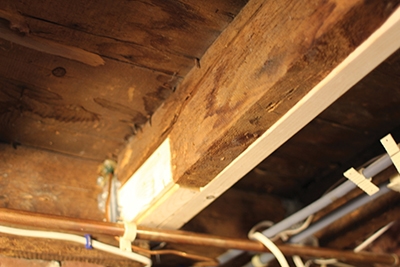
How To Repair A Notched Ceiling Joist,
Source: https://extremehowto.com/fixing-a-damaged-floor-joist/
Posted by: mckinneysormse.blogspot.com


0 Response to "How To Repair A Notched Ceiling Joist"
Post a Comment